This year marks the 20th anniversary of the event that was launched by Pet Sitters International in 1996. First celebrated in the dog-loving U.K., Take Your Dog To Work Day crossed the pond in 1999. Americans embraced it with gusto and have turned it into a full-fledged holiday.
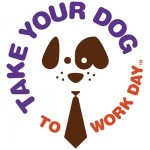 The purpose of Take Your Dog To Work Day, which is always commemorated the Friday after Father’s Day, is threefold. Pet Sitters International (PSI) wanted to not only celebrate the human-canine connection, but also demonstrate how canines can have a positive effect on the workplace. The organization also wanted the day to serve as a reminder that shelters all over the world are filled with animals in need of forever homes. PSI was hopeful that people without dogs would discover the joys of owning a pet through interacting with them in the workplace and make a beeline for a shelter.
The purpose of Take Your Dog To Work Day, which is always commemorated the Friday after Father’s Day, is threefold. Pet Sitters International (PSI) wanted to not only celebrate the human-canine connection, but also demonstrate how canines can have a positive effect on the workplace. The organization also wanted the day to serve as a reminder that shelters all over the world are filled with animals in need of forever homes. PSI was hopeful that people without dogs would discover the joys of owning a pet through interacting with them in the workplace and make a beeline for a shelter.
As a result, offices and shelters alike have benefited from Take Your Dog To Work Day (which is quickly morphing into Take Your Dog To Work Week). While work is probably given a low priority that day, it proves to be productive in other ways: stress levels plummet while office morale climbs. “Just stroking a dog lessens stress,” Dr. Marty Becker, author of The Healing Power of Dogs and a proponent of “Labradors over Lipitor,” told ABC News in 2014.
Shelters are also benefiting. Many dog-loving businesses have dedicated the day to creating awareness and holding fundraising endeavors for shelters.
In honor of Take Your Dog To Work Day, we are celebrating the unique connection that exists between humans and canines. Meet some dogs who accompany their humans to work on a regular basis.
For more information about Take Your Dog To Work Day, visit takeyourdog.com or facebook.com/takeyourdog.
Kathy Frey Terkeltaub with Turk and Millie
It’s probably fair to say that Kathy is a pioneer in Lancaster when it comes to taking a dog to work. Eight-year-old Turk has been a fixture at Festoon, first as a puppy at the Hager Arcade and then growing along with the store’s expansion and last year’s move to the Firehouse on North Duke Street.
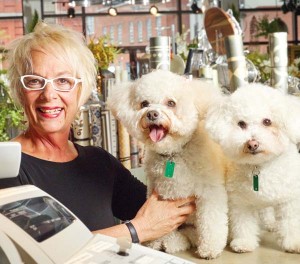 Turk, a Bichon Frise, shares cuteness duties at the store with his adopted sister, 6-year-old Millie, a Maltipoo (a Maltese/Poodle crossbreed). “I’ve always been an animal person,” says Kathy. “I’m a horse and dog girl!”
Turk, a Bichon Frise, shares cuteness duties at the store with his adopted sister, 6-year-old Millie, a Maltipoo (a Maltese/Poodle crossbreed). “I’ve always been an animal person,” says Kathy. “I’m a horse and dog girl!”
Needless to say, Turk and Millie are treasured members of the family. “They’re our children,” Kathy says, referring to her husband, Bruce, who ferries the dogs between their home and the store when they become restless or are in need of quiet time. “Turk’s more customer-oriented,” Kathy observes. “Millie is a bit shy.” The couple is so attached to Turk and Millie that they purchased a motor home so their pets don’t have to stay in a kennel while they travel. “We have a lot of fun,” Kathy says of their RVing adventures.
Kathy’s stores – downtown and at Brighton Village – are canine friendly. Dog walkers often stop in to browse, and “we have lots of service dogs come in. We welcome them all,” Kathy reports. “I feel if dogs are well behaved, why not invite them in?”
The store also sells petcentric items that range from books and food/water bowls to throw pillows (which exhibit images of canines), vinyl floor cloths and room scents. “But, I don’t sell clothing for dogs!” she stresses. “I don’t dress my dogs up. When I had the dogs groomed for the photo shoot, the groomer put small ribbons behind Millie’s ears. That’s as far as I’m willing to go!” But, fashions and accessories for women? Well, that’s a whole other story.
Festoon: 202 N. Duke St., 299-2232, and 1183 Erbs Quarry Rd., Lititz, 560-6509. Shopfestoon.com.
Craig Patterson and Dixie
Craig Patterson, who heads Patterson Financial Services, couldn’t sell his landlord on the notion that his Goldendoodle, Dixie, came to the office to do typing and filing. “He didn’t buy it,” Craig shrugs.
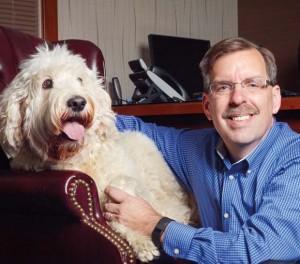 So, Craig decided to become his own landlord in order to bring Dixie to work with him. “I started looking around just as the recession struck and kept at it, deciding it was a good time to buy real estate,” he explains. He found a prime location – a former dental office – along Millersville Road, made an offer
So, Craig decided to become his own landlord in order to bring Dixie to work with him. “I started looking around just as the recession struck and kept at it, deciding it was a good time to buy real estate,” he explains. He found a prime location – a former dental office – along Millersville Road, made an offer
and found himself the owner of a
commercial building. Two years ago, after his lease had expired and remodeling on the building was completed, Craig and Dixie made the move. “It’s a great location for us,” he says, noting they’re now only about 10 minutes from home and no longer fight cross-town traffic to get to the office. “Our clients like it, too,” he says, referring to the convenience factor.
Ten-year-old Dixie heads the office’s welcoming committee. She greets clients at the door and accompanies them into the conference room. After a few minutes, Craig gives her the signal to leave the room by pointing at the door, and she rejoins treat dispenser Wendy Benner in the reception area.
Craig finds that Dixie not only provides comic relief, but also stress relief. “Discussing their financial future can be stressful for some people,” he observes. “Petting Dixie for a while seems to work magic; it breaks the ice and has a calming effect. Some people will even request that she stay [for the meeting].”
Dixie will also go on the road with Craig. “I have a client who lives at a local retirement community and requests that I bring Dixie along for our meetings, so I take her with me,” he says of Dixie’s part-time job as an unofficial pet therapist. Otherwise, Dixie holds down the fort with Wendy. Yes, dog-sitting was listed as one of the duties of the job.
Craig and his wife, Lyn, realize that retirement is looming for Dixie, and they are grooming her replacement. Zoe, a mini Goldendoodle, is spending puppyhood at home. “She’s a little too wild for the office right now,” Craig reports. “Hopefully, we’ll soon be able to bring her in for short periods of time so that Dixie can begin teaching her the ropes.”
Patterson Financial Services: 22 Millersville Rd. 295-9612 or pattersonfinancialservices.net.
- Instead of bringing your dogs to work, go on a group outing to a local shelter and perform some volunteer work: walk dogs, beautify the outdoors, paint a room, etc.
- Have a fundraiser for a shelter/rescue group at your office.
- Visit a shelter’s website. There’s usually a list of things they need. Post the list a week ahead of Take Your Dog To Work Day and encourage participation by having a contest of some kind. Winner receives dinner at a restaurant, gift certificates, a free day off, etc.
Officer Ryan Hockley and Leo (Ret.)
The American Kennel Club (AKC) defines the German Shepherd as “smart, confident, courageous and steady.” Consequently, these working dogs have gone from being sheep herders in their native Germany to serving as guide dogs for the vision-impaired and joining the ranks of military forces and police departments the world over.
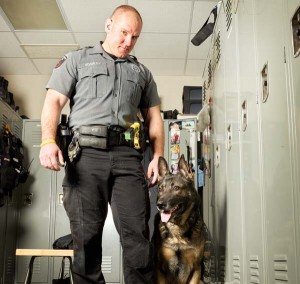 Ryan Hockley traces his interest in having a canine partner to his days in the Air Force. “I was around military dogs a lot,” he explains.
Ryan Hockley traces his interest in having a canine partner to his days in the Air Force. “I was around military dogs a lot,” he explains.
Ryan, who is a third-generation police officer, joined the Lancaster Police Department 10 years ago. In 2009, he applied to work with the K-9 Unit and was eventually assigned to Leo, a German Shepherd who hails from Slovakia in Central Europe. Like all of the department’s dogs, Leo came to Lancaster via Castle’s K-9 in Mechanicsburg, which offers on-going training for the police departments it services. Leo’s expertise includes patrol and narcotics detection.
According to Ryan, Leo is ever vigilant. “When he’s on duty, he’s barking nine out of the 10 hours,” he notes, adding that in most cases, his bark is worse than his bite (so long as you’re abiding by the law). “He’s not a mean dog,” Ryan reports. Leo’s exploits have resulted in apprehensions, flushing bad guys out of hiding, and detecting everything from drugs to guns. Like human partners, the two have each other’s back.
At the end of their shifts, the city’s police dogs head home with their partners and smoothly transition into family pets. “He rarely barks at home, and he lets my 2-year-old son climb all over him,” Ryan says of Leo. He also peacefully coexists with the family’s cats.
On April 15, Leo went out on his last patrol. Soon to celebrate his 8th birthday (60 years or so in human terms), the department determined Leo had done his duty. But, he and Ryan will remain partners. Leo has retired to being the Hockley family’s full-time pet and will be receiving his pension in the form of treats, toys and naps. As for Ryan, he too is transitioning out of the K-9 Unit and has made becoming a detective his next goal.
Officer Ben Bradley and WodAn
The Belgian Malinois is described by the AKC as being “smart, confident, hardworking and steadfastly loyal.” In Officer Ben Bradley’s estimation, that perfectly sums up his partner, Wodan.
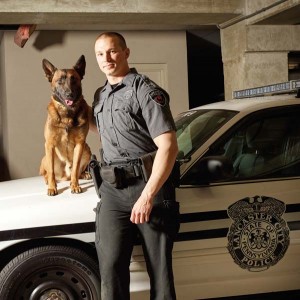 While the navy seals are given the lion’s share of credit for the successful raid on the compound in which Osama Bin Laden lived out his days, in reality a dog led the way. Like his seal partners, the dog’s identity – or breed – has never been revealed. A few pictures exist, prompting people to speculate that the dog was a Belgian Malinois or a German Shepherd. More than likely, the dog’s role was to detect IEDs or other explosives.
While the navy seals are given the lion’s share of credit for the successful raid on the compound in which Osama Bin Laden lived out his days, in reality a dog led the way. Like his seal partners, the dog’s identity – or breed – has never been revealed. A few pictures exist, prompting people to speculate that the dog was a Belgian Malinois or a German Shepherd. More than likely, the dog’s role was to detect IEDs or other explosives.
The Malinois traces its breeding to the Belgian city of Malines. Like other members of the “working dog” group, the Malinois needs to have a job in order to satisfy its intellect and energy level, both of which are very high. As a result, the dog went from sheepherding and guarding livestock to being the top choice of police departments and the military. According to a 2011 New York Times article, the Belgian Malinois has the ability to “sniff out the enemy from two miles away.”
Like Leo, Wodan arrived in Lancaster through Castle’s K-9. “I view him as a tool,” Ben says. “He’s a fellow officer who just happens to be my partner.” Wodan, who has been Ben’s partner for a year, specializes in explosive detection.
Like the other K-9 partnerships, once their shift is completed, Ben and Wodan head for home. “Wodan’s a very social dog,” Ben says of the dog’s relationship with the family’s other dog and his two children. “One day I looked into my daughter’s nursery, and he was laying by the crib,” he recalls. “My other daugther crawls all over him.” However, Wodan’s social side doesn’t extend to palling around with other dogs at the local dog park. “That wouldn’t work,” Ben observes. “When he needs to run off some energy, I find an empty field and let him go.”
Specialized dogs such as Leo and Wodan are highly valuable, costing as much as $20,000 to import and train. These canine officers are not part of the department’s budget and instead their expenses are paid for by the Lancaster City Police Foundation and private donations. Knowing Leo’s retirement was approaching, the Foundation set to work to replace him as well as another previously retired dog. Once again, Castle’s K-9 found appropriate dogs and put them and their human partners through training. They began their duties in early May. In addition to Officer Bradley and Wodan, the K-9 teams now include Officer Steven Alexander and Axel, Officer Jon Reppert and Stryker, and Officer J. Hatfield and Zoltan. In addition to funding the purchase and training of the dogs, the Foundation has also provided heat alarms for patrol cars and bulletproof vests for the dogs.
Donations are always welcome. Visit lancasterpolicefoundation.org.
Dr. John Weierbach, II, with Gracie, Mazie & Lily
Dental health is very important at the Weierbach residence. Even before he heads to the office, Dr. John Weierbach is on the job. He attributes his dogs’ pearly whites to the Greenies he or his wife, Kathy, dispenses every morning.
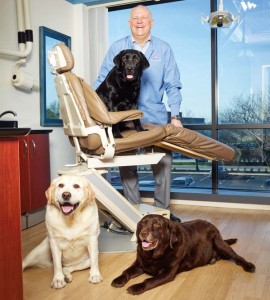 The Weierbachs became a Lab-loving family as a result of their daughter, Lindsay, attending school in Maine. Students were afforded the opportunity to work with a local breeder, training puppies to become obedient and polite family members. Lindsay was paired with a Chocolate Labrador Retriever. The two formed a special bond. “When Lindsay came home, Gracie came with her,” Dr. Weierbach reports. Gracie, who is now 10, needed a companion, so the Weierbachs contacted the same kennel and Mazie, a Yellow Lab who is now 7, joined the family.
The Weierbachs became a Lab-loving family as a result of their daughter, Lindsay, attending school in Maine. Students were afforded the opportunity to work with a local breeder, training puppies to become obedient and polite family members. Lindsay was paired with a Chocolate Labrador Retriever. The two formed a special bond. “When Lindsay came home, Gracie came with her,” Dr. Weierbach reports. Gracie, who is now 10, needed a companion, so the Weierbachs contacted the same kennel and Mazie, a Yellow Lab who is now 7, joined the family.
Fast-forward a few years. Lindsay was now living on her own. Gracie and Mazie had formed such a bond that she didn’t want to break them up, so they remained with her parents. “Then, Lindsay came to me and said she wanted to get a dog,” Dr. Weierbach recalls. They contacted a breeder in Mansfield and went to check out the litter. “Lindsay made her pick, which left only one. So, we came home with two dogs,” he says of Black Lab Lily, who is 2 years old.
Characters might best define this trio of Labs. “They’re always into something,” Dr. Weierbach says. He tells of arriving home one day with Kathy, only to find her unmentionables strewn across the front yard. “They got into the laundry and apparently had a good time,” he says of having to retrieve items from the lawn and shrubs. “I can only imagine what the neighbors thought.”
an anxious patient motivated Dr. Weierbach to experiment with bringing the dogs to the office to dispense their special brand of TLC. “They know what the word ‘office’ means and tear to the car when they hear it,” he notes, adding that they take turns accompanying him to the office.
The dog of the day passes the time in one of the private offices until her assistance is needed. “We’re sensitive to the fact that not everyone is a dog lover like we are, plus we want to maintain a sterile environment,” Dr. Weierbach says of the precautions that are taken.
Nevertheless, Gracie, Mazie and Lily have become well known among the patients – one patient even named her new dog after Mazie. The staff immediately noticed that interacting with the dogs seemed to make people forget they’re at the dentist. “Just petting them seemed to have a calming effect,” Dr. Weierbach observes.
Increasingly, patients began to ask if one of the dogs could accompany them into the exam rooms. “I have some patients who won’t have work done unless one of the dogs is here,” he reports. “One woman came in for her appointment, saw that a dog wasn’t here, and said she’d have to reschedule.”
Even discussing dogs seems to alieve patients’ stress levels. One patient was extremely uneasy about the procedure he would be undergoing, which prompted Dr. Weierbach to ask if he would be more comfortable if he brought one of his own dogs along for the appointment. “He brought one of his Goldens, and it worked out great,” Dr. Weierbach reports. Another patient brings her teacup-sized dog in a carrying case and perches it atop herself while she’s in the dental chair. “Whatever works,” Dr. Weierbach says of making patients feel comfortable.
John A. Weierbach, II, D.M.D.: 160 North Pointe Blvd., Suite 203. 560-9190 or yourclassicsmile.com.
- Even before the big day, check with office mates in the immediate vicinity to make sure they are not allergic to dogs.
- The day before, check your office for loose electrical wires, food and toxic plants. Empty your trash can, too.
- Don’t force your dog to interact with co-workers or other dogs. Let them do it at their own pace.
- Monitor your dog’s reactions to the over stimulation they may be receiving. Excessive panting and licking are indications they are feeling overwhelmed.
- Bring along a water bowl, treats and food.
- Bring a bed or blanket for napping.
- Be sure to schedule plenty of breaks; take a walk at lunch time.
- Bring along plenty of doggie bags.
- Place a sign on your office door to let others know your dog is with you.
- Have a lint brush handy.

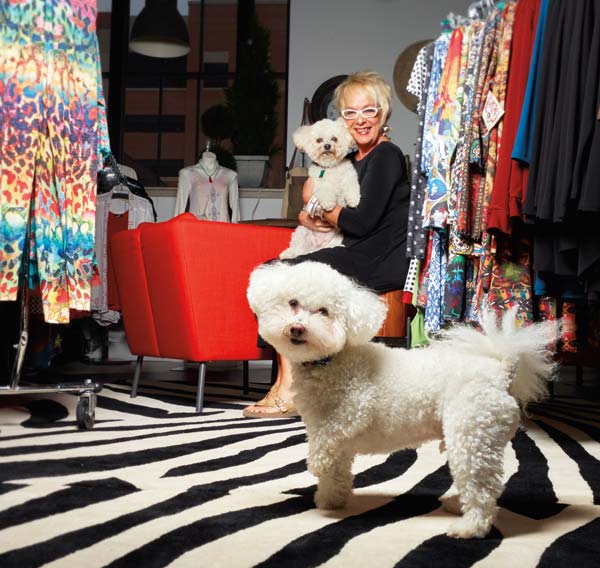
Leave a Reply